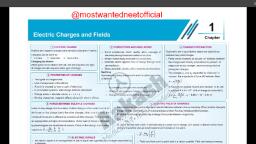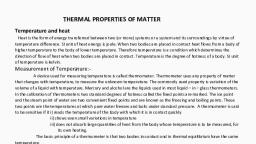Page 1 :
Chapter 1 1, , Thermal Properties of Matter, , , , Introduction Introduction, Temperature and Heat When a body is heated, various changes take place. The temperature, of the body may rise, accompanied by an expansion or contraction of, ¢ Measurement of the body; or the body may liquefy or vaporise with no change in, Temperature temperature. In this chapter we will examine some of the thermal, . properties of matter and some of the important processes involving, © Ideal Gas Equation and thermal energy. We will first consider thermal expansion which plays, Absolute Temperature an important role in everyday life and then discuss changes of phase, © Thermal Expansion and latent heat. At the end, we will discuss the phenomenon of heat, transfer., e Specific Heat Capacity, © Calorimetry TEMPERATURE AND HEAT, e Change of State Temperature is a relative measure, or indication of hotness or coldness. Ahot, cooker is said to have a high temperature, and ice cube to have a lower, ¢ Heat Transfer temperature., ¢ Newton's Law of Cooling An object at a higher temperature is said to be hotter than the one at a lower, temperature., e Some Important Definitions, The Si unit of temperature is kelvin (k), whereas degree celsius (°C) is a, © Formulae Chart commonly used unit of temperature. When you put a cold spoon into a cup of, , hot coffee, the spoon warms up and the coffee cools down as they were trying, to equalise the temperature. The interaction that causes these temperature, changes is fundamentally a transfer of energy from one substance to another., Energy transfer that takes place solely because of a temperature difference is, called heat flow or heat transfer and energy transferred in this way is called, heat. The SI unit of heat energy transferred is expressed in joule (J)., , e Quick Recap, , Note : Temperature vs. Heat : It is absolutely essential for us to keep, clearly in mind the distinction between temperature and heat. Temperature, depends on the physical state of a material and is a quantitative description, of its hotness or coldness. In physics the term “heat” always refers to, energy in transit from one body or system to another because of a, temperature difference and never to the amount of energy contained within, @ particular system., , Aakash Educational Services Pvt. Ltd.-Regd. Office: Aakash Tower, 8, Pusa Road, New Delhi-110005 Ph.011-47623456
Page 2 :
204 Thermal Properties of Matter Board & Competitive Exams., , MEASUREMENT OF TEMPERATURE, Celsius and Fahrenheit temperature scales, A physical property that changes with temperature is called a thermometric property., Any thermometric property can be used to establish a temperature scale. The common mercury thermometer, , consists of a glass bulb and tube containing a fixed amount of mercury. When this thermometer is put in contact, with a hot body, the mercury expands, increasing the length of the mercury column., , A scale of temperature can be created along the glass tube as follows:, , The thermometer is first placed in ice and water in equilibrium at a pressure of 1 atm. When the thermometer, attains the temperature of ice-water bath, the position of the mercury column is marked on the glass tube., This is the ice point temperature. The thermometer is next placed in boiling water at a pressure of 1 atm. When, the thermometer attains the temperature of boiling water, the new position of the mercury column is marked., This is the steam point temperature., , 1. Celsius Scale : This scale was designed by Andre Celsius in 1742. It defines ice-point temperature as, 0°C and the steam point temperature as 100°C. The space between 0°C and 100°C marks is equally, divided into 100 intervals., , 2. Fahrenheit Scale : This scale was designed by Fahrenheit in 1717. It defines the ice-point temperature, as 32°F and the steam point temperature as 212°F. The space between 32°F and 212°F is divided into, 180 equal intervals., , 3. Relation between Celsius temperature (t,) and Fahrenheit temperature (f,) : We know that there, are 100 Celsius degrees and 180 Fahrenheit degrees between ice and steam points., , To convert a temperature from one scale to the other, we must take into account the fact that zero, temperatures of the two scales are not the same. Clearly, , , , , , , , ie, to= Ste -32), , ope Ste +92 Ai), , The normal temperature of the human body measured on the Celsius scale is 37°C which is 98.6°F., , , , Content Builder, , , , Short Description of Various Thermometers, , , , t tv Jv t, Resistance, , Expansion Thermoelectric Radiation, (liquid) Thermometers Thermometers, meters, , , , , , Aakash Educational Services Pvt. Ltd.-Regd. Office: Aakash Tower, 8, Pusa Road, New Dethi-110005 Ph.011-47623456
Page 3 :
Board & Competitive Exams. Thermal Properties of Matter 205, , , , Mercury Thermometer : Fahrenheit was the first to choose mercury as the thermometric substance, on account of its many advantages. It doesn't wet glass, can be easily obtained pure, remains liquid, over a fairly wide range, has a low specific heat and high conductivity, it is opaque and its expansion, is approximately uniform and regular. Its disadvantages are that the specific gravity and surface, tension of mercury are large, and the angle of contact with glass when mercury is rising, is different, from that when it is falling., , The range of an ordinary mercury thermometer is limited by the fact that mercury freezes at, — 38.87°C and boils at 356°C but the upper limit can be realised to about 500°C by filling the top, of the tube with nitrogen under pressure. If instead of mercury we happen to use Alcohol we can, measure as low as — 111°C and petroleum ether can measure as low as — 190°C., , Gas Thermometers : Gas Thermometers are more sensitive than liquid thermometers as expansion, of gases is more than that of liquids. They are most accurate (primary standard thermometers), thermometers and hence utilized to calibrate all secondary thermometers. The major disadvantage, is that they take almost an hour to record a given temperature that's why we use a lot of secondary, thermometers. Their temperature range is between — 260°C to 1600°C. Gas thermometers are based, on the ideal gas equation and as you know real gases behave approximately like an ideal gas only, at low pressure and high temperature so very small amount of gas is filled in gas thermometers, so that pressure remains low., , P, is pressure of gas at 0°C, P09 iS pressure of gas at 100°C, P, is pressure of gas at PC., The pressure and temperature are related as, , Pi-P _ _t-0, PoP) 100-0, , Resistance Thermometers : The platinum resistance thermometer works on the principle of, Wheatstone bridge (you'll study in class XII). These thermometers are based on the fact that, resistance of metals varies with temperature according to the relation., , R=R, [1+ off, , where, R, = resistance at 0°C and « = temperature coefficient of resistance and R is the resistance, at temperature (°C., , If Ryo is resistance measured at 100°C and, R, is resistance measured at °C,, then the resistance and temperature are related as, , R,-Ro __t-0, Rio Ry 100-0, , , , In such thermometers “Stem Corrections” are eliminated by the use of compensating leads. These, thermometers can measure temperature even from a distance and becomes extremely useful, for measuring temperatures where human beings don't go e.g. furnace, poisonous gases etc. The, temperature is from — 182°C to 1200°C., , , , , , , , Aakash Educational Services Pvt. Ltd.-Regd. Office: Aakash Tower, 8, Pusa Road, New Delhi-110005 Ph.011-47623456
Page 4 :
206 Thermal Properties of Matter, , Board & Competitive Exams., , , , Thermoelectric Thermometers : It is based on Seebeck effect (you'll study that in class XII). In, this thermometer two distinct metals are joined to form a closed circuit known as thermocouple., One junction is generally kept in ice and the other junction is placed on the body whose temperature, is to be calculated. A current flows in the circuit given by current = aT + bT? where a, b are, constants and T is temperature. Such thermometers have several advantages. They can easily, measure fast changing temperatures. Since temperature is in the form of electric current a computer, can do the recording of changing temperature over a time interval and it can even be sent through, satellites etc. from one place to other. Different parts of our body has different temperature and it, can easily make temperature diagrams of our body to be shown on a computer. It has very wide, application in engineering and medical world. The temperature range is (— 320°C to 1600°C), , Pyrometers : These devices are based on Stefan’s law which says radiations received is proportional, to fourth power of the absolute temperature of the body. It measures very high temperatures [pyre, means fire] say that of a furnace etc. The temperature of the sun is measured by pyro-helio-meter., , Vapour Pressure Thermometers : Its use is based on the well-known fact that the vapour-pressure, of a liquid varies uniquely with the temperature. The method consists simply in measuring the vapour, pressure of a certain liquid at the required temperature., , Magnetic Thermometers : Temperatures below 1 K are measured by ‘magnetic thermometers’, which uses the principle of adiabatic demagnetisation. It is based on Curie-Law according to which, magnetic susceptibility of a paramagnetic salt varies inversely as its absolute temperature., , , , , , , , IDEAL GAS EQUATION AND ABSOLUTE TEMPERATURE, , Experiments show that all gases at low densities exhibit same expansion behaviour. When temperaure is kept, constant, the pressure and volume of a quantity of gas are related as PV = constant (Boyle's law)., , Pressure, , f -200°c -100°C °C 100°C Temperature, -273.15°C, , When the pressure is held constant, the volume of a quantity of the gas is related to the tempeturate as, , Vv, tT" constant (Charles’ law). These two relations may be combined into a single relationship., , PV=K (i), Vv ” r, vek ii), PV _ constant, , T, , This relationship is known as ideal gas law., It can be written in more general way as, , Aakash Educational Services Pvt. Ltd.-Regd. Office: Aakash Tower, 8, Pusa Road, New Dethi-110005 Ph.011-47623456
Page 5 :
Board & Competitive Exams. Thermal Properties of Matter 207, , PV =uRT where 1 = Number of moles of gas, R = Universal gas constant (R = 8.31 J mol K-"), P= Pressure of gas, V = Volume of gas, , The absolute minimum temperature is equal to —-273.15°C. This is also known as absolute zero. Absolute zero, is the foundation of the kelvin temperature scale or absolute scale temperature., , Absolute Temperature Scale :, , When different types of thermometers are calibrated in ice-water and steam, they agree at 0°C and 100°C,, but give slightly different readings at points in between. Discrepancies increase above the steam point and below, the ice-point. However, in gas thermometers, measured temperature agree closely with each other even far from, the calibration points. In one type of gas thermometer, called a constant-volume gas thermometer, the volume, of the gas is kept constant and change in the pressure of the gas is used to indicate temperature., , By placing the thermometer in ice-water and water-steam baths, ice-point pressure P, and steam-point pressure, Pio9 are determined. The interval between P,,. and P, is divided into 100 equal intervals (for Celsius scale)., If P, is the pressure in a bath whose temperature f, is to be determined, then, R-P _Panh, , te «100, , , , , , ), , Equation (iii) suggests that the pressure (P,) in the thermometer varies linearly with the measured temperature, ft, and as such a graph of P, versus {,, is a straight line., , Platm), , Plots of pressure as a function of, temperature for gas thermometers, , , , , , , , , containing different types and, quantities of gas, Dashed lines show the plots, extrapolated to zero Loti t f t | TC), eres —273.15 -200 -100 0 100 200, + + TK), , 0 100 200 300 400 500, , Fig.: The extrapolated plots all reach zero pressure, at the same temperature — 273.15°C., , When we extrapolate this straight line to zero pressure, the temperature approaches — 273.15°C. This limit, which is the same no matter what kind of gas is used, is called the absolute zero. A temperature scale based, on this zero is called absolute temperature scale or Kelvin scale. Thus,, , OK =— 273.15°C, , The degrees (interval) on Kelvin scale are of the same size as on the celsius scale. Thus, a temperature, change of 1°C is the same as change of 1 K, i.e.,, , 1 celsius degree (C°) = 1 kelvin (K), , Aakash Educational Services Pvt. Ltd.-Regd. Office: Aakash Tower, 8, Pusa Road, New Delhi-110005 Ph.011-47623456

























































